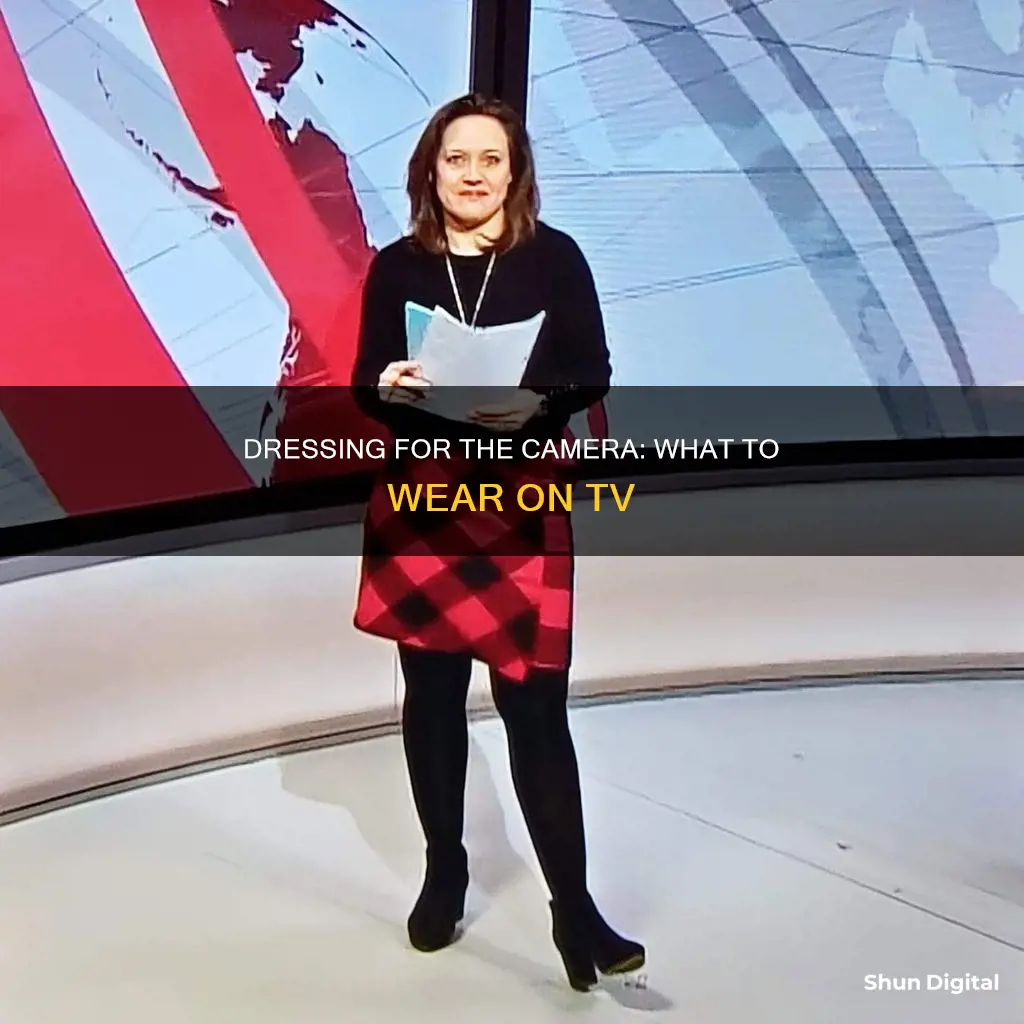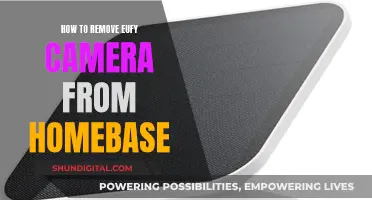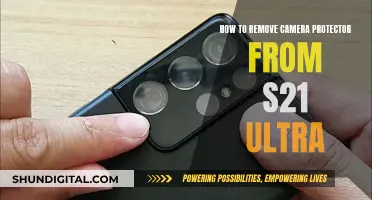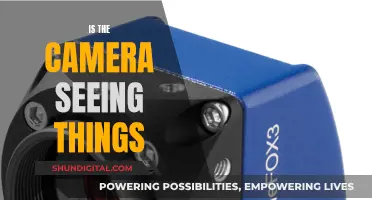
If you're going to be in front of a camera, it's important to think about what you're going to wear. The clothes you choose can have a significant impact on how you are perceived by viewers, so it's worth putting some thought into your outfit. Here are some key things to consider when deciding what to wear for a TV appearance.
| Characteristics | Values |
|---|---|
| Colors | Avoid bright red, orange, white, black, green, yellow, purple, and hot pink. Wear blue, pastels, lilac, gray, brown, and natural tones. |
| Patterns | Avoid herringbone, plaids, checks, stripes, and bold prints. |
| Jewelry | Keep to a minimum. Avoid dangly earrings, necklaces, and bracelets. |
| Makeup | Wear makeup to hide undereye circles or flaws in your complexion. Stick to neutral, muted shades. |
| Wrinkles | Wear wrinkle-free clothing. |
| Fit | Wear well-fitted clothing. |
| Skirts/Dresses | Avoid short skirts/dresses. |
| Socks | Wear knee-length socks. |
| Logos | Avoid wearing logos. |
What You'll Learn

Wear colours that complement the background and your skin tone
When choosing what to wear on TV, it's important to consider colours that complement both the background and your skin tone.
First, you should research the show and the setting. Find out if guests usually sit in front of a backdrop and the studio's seating arrangement. This will help you determine the colours that will make you stand out from the background. For example, if you're filming in front of a green screen, avoid wearing any shade of green.
When it comes to colour choices, blues, grays, magentas, and browns are generally good options. Pastel colours are also a safe choice as they are easy on the eye and the camera. These colours are less likely to cause lighting problems or wash out your complexion.
Additionally, consider colours that complement your skin tone. For example, if you have a warm skin tone, earth tones and jewel tones like emerald, ruby, and amber may flatter your skin. If you have a cool skin tone, colours like blue-red, fuchsia, and violet may be more flattering.
It's also important to avoid certain colours and patterns. Stay away from black and white, as they can be unflattering under harsh lighting and cause lighting problems. Bright red and orange colours should also be avoided as they can bleed on camera. Bold patterns and stripes should be avoided as they can create a distracting optical effect called a moiré pattern.
By choosing colours that complement both the background and your skin tone, you can ensure that you look your best on TV and that the focus remains on your message.
Surveillance Cameras: Where Are They Watching?
You may want to see also

Avoid black, white, bright red, and green
When getting dressed to appear on TV, it's important to keep in mind that the colours and patterns you see in person will be captured differently by the camera lens. The goal is to wear something that helps you engage your audience, not distract them. So, what colours should you avoid?
Black
Black tends to absorb a lot of the surrounding light, making details less visible. This can make it hard for the camera to balance exposure and work out where your arms end and your torso begins, potentially making you look wider. If you must wear black, it's best to wear it on the lower half of your body.
White
White can be too visually overwhelming and can dominate the screen. It can also be too bright, "blinding" the viewer.
Bright red
Red tends to look orange to the camera and can make your face look flushed.
Green
Green is a risky colour to wear on TV, especially if there will be a green screen. You could end up blending into the background!
In general, it's best to avoid wearing extremely bright colours like hot pink, yellow, and orange. You should also steer clear of patterns like stripes, herringbone, and plaids, as these can create a weird optical effect called a moiré pattern, which can be dizzying for viewers.
Exiting the Watchful Eye of Cameras: A Guide to Evading Surveillance
You may want to see also

Avoid busy patterns and stripes
When dressing for a TV appearance, it's important to wear something that makes you look and feel good, while also considering the technical limitations of the camera.
Stripes and busy patterns are a common pitfall when it comes to choosing an outfit for TV. On screen, these patterns can create a weird optical effect called a moiré pattern, where the lines or shapes appear to move or vibrate, which can be distracting for viewers. This effect is caused by competing patterns fighting for visual dominance. The smaller the pattern, the more likely it is to create this unwanted effect.
To avoid this, opt for solid colours or muted, subdued patterns. Large, bright patterns can also be distracting, drawing attention away from what you're saying.
If you're unsure about your outfit choice, it's a good idea to bring a few different options to the shoot. You can also do a practice run beforehand, filming yourself with a smartphone to see how the outfit looks on camera.
The Tiny Dot Pinhole Camera's Intriguing Viewpoint
You may want to see also

Wear comfortable, breathable clothing
When getting ready for a TV appearance, it's important to wear comfortable, breathable clothing. The studio lights are hot, and you don't want to be fidgeting or adjusting your clothes. Sweating is also a concern, so opt for breathable fabrics like cotton. Avoid heavy fabrics like wool and wool-flannel.
If you're wearing a suit, make sure it fits well and is made from lightweight material. A dress shirt and tie can also be a good option, especially if you tend to sweat a lot. If you're still concerned about sweating, consider wearing a performance undershirt in light grey or white to keep your body cool and absorb sweat.
For women, a fitted sheath dress is a great option. It flatters most body types, allows room for a mic pack, and prevents excess fabric from being visually distracting. Avoid short skirts, as you may find yourself constantly tugging at the hem or feeling distracted by the amount of leg on show.
Whether you're a man or a woman, avoid billowy or loose-fitting clothing, as it can make you look frumpy. Make sure your clothes are nicely fitted and wrinkle-free.
Lastly, consider the setting of your appearance. If you'll be standing or sitting behind a desk, comfortable shoes aren't a priority. But if you'll be walking or standing for long periods, choose footwear that won't leave your feet sore and blistered.
Understanding the TV Setting on Your Camera
You may want to see also

Avoid scarves, turtlenecks, and excessive jewellery
When it comes to what to wear on TV, there are several things to keep in mind to ensure you look your best and avoid any distractions. One of the key things to remember is to avoid scarves, turtlenecks, and excessive jewellery.
Scarves and turtlenecks can pose a problem when it comes to audio quality. Scarves may rub against your microphone, creating unwanted noise, while turtlenecks can muffle your audio, making it difficult for viewers to hear you clearly. It's important to ensure your voice is conveyed effectively, so it's best to steer clear of these items.
Excessive jewellery is another pitfall to avoid. Large, jangly pieces can be visually distracting and may also create noise if they rub or jangle against your microphone. Keep jewellery to a minimum and opt for smaller, more delicate pieces that won't detract from what you're saying.
When choosing what to wear, it's also important to consider the lighting and the potential for glare. Avoid metallic or shiny jewellery that may reflect the bright TV lights and distract viewers. Stick to simple, understated pieces that complement your outfit without drawing too much attention.
Additionally, consider the colour of your clothing. While black and white can be problematic for lighting and exposure reasons, colours like blue, grey, and pastel shades tend to work well on camera. They provide a calming effect and are easy on the eyes, ensuring the focus remains on your message rather than your attire.
In summary, when dressing for a TV appearance, it's crucial to avoid scarves, turtlenecks, and excessive jewellery. These can interfere with audio quality, create unwanted noise, and distract from your message and overall presentation. Opt instead for simple, understated jewellery and clothing in colours that complement your skin tone and the lighting conditions.
TCL Roku TV: Built-In Camera or Not?
You may want to see also
Frequently asked questions
Avoid wearing black, white, bright red, orange, yellow, purple, and green. Black and very dark colours are usually okay when worn on the lower half of the body. White can be too visually overwhelming and "blind" the viewer. Red and orange tend to look orange on camera. Purple and green are hard for the camera sensor to compensate for.
Wear colours that flatter your face, such as pastels, purples, browns, and blue.
Avoid wearing stripes, herringbone, plaids, checks, and large or small patterns. These patterns can create a weird optical effect called a moiré pattern, where competing patterns compete with each other for visual dominance.
Wear nicely fitted clothing that is wrinkle-free and comfortable. Avoid loose, billowy, or wrinkled clothes as they can make you look frumpy.
Avoid wearing noisy, flashy, or reflective jewellery. Keep jewellery to a minimum, especially earrings.







